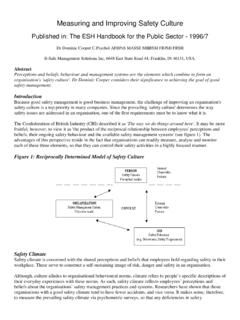Transcription of Fourth Grade United States History - Georgia Standards
1 Social Studies Georgia Standards of Excellence Georgia Department of Education June 9, 2016 Page 1 of 6 Fourth Grade United States History Year 2: Revolution to Reconstruction In Fourth Grade , students continue with year two of a three year study of United States History in which all four strands ( History , geography, civics/government, and economics) are integrated. Students begin the year learning about the French and Indian War and end with the Reconstruction period. The geography strand emphasizes the influence of geography on History during these same time periods.
2 In the civics/government strand, students learn about concepts and rights contained within our founding documents. The economic strand uses material from the History strand to deepen understanding of economic concepts. Historical Understandings SS4H1 Explain the causes, events, and results of the American Revolution. a. Trace the events that shaped the revolutionary movement in America: French and Indian War, 1765 Stamp Act, the slogan no taxation without representation, the activities of the Sons of Liberty, the activities of the Daughters of Liberty, Boston Massacre, and the Boston Tea Party.
3 B. Describe the influence of key individuals and groups during the American Revolution: King George III, George Washington, Benjamin Franklin, Thomas Jefferson, Benedict Arnold, Patrick Henry, John Adams, Paul Revere, and Black regiments. c. Describe the major events of the American Revolution and explain the factors leading to American victory and British defeat; include the Battles of Lexington and Concord, Saratoga, and Yorktown. d. Explain the writing of the Declaration of Independence; include who wrote it, how it was written, why it was necessary, and how it was a response to tyranny and the abuse of power.
4 SS4H2 Analyze the challenges faced by the framers of the Constitution. a. Identify the major leaders of the Constitutional Convention (James Madison, George Washington, and Benjamin Franklin). b. Evaluate the major issues debated at the Constitutional Convention: the weaknesses of the Articles of Confederation, the rights of States to govern themselves (federal system), the Great Compromise, and slavery (Three-Fifths Compromise). Social Studies Georgia Standards of Excellence Georgia Department of Education June 9, 2016 Page 2 of 6 SS4H3 Explain westward expansion in America.
5 A. Describe the causes and events of the War of 1812; include the burning of the Capitol and the White House and the writing of The Star Spangled Banner. b. Describe the impact of westward expansion on American Indians; include the Trail of Tears, Battle of Little Bighorn and the forced relocation of American Indians to reservations. c. Describe territorial expansion with emphasis on the Louisiana Purchase, the Lewis and Clark expedition, and the acquisitions of Texas (the Alamo and independence), Oregon (Oregon Trail), and California (Gold Rush and the development of mining towns).
6 SS4H4 Examine the main ideas of the abolitionist and suffrage movements. a. Discuss contributions of and challenges faced by Susan B. Anthony, Frederick Douglass, Elizabeth Cady Stanton, Sojourner Truth, and Harriet Tubman. SS4H5 Explain the causes, major events, and consequences of the Civil War. a. Identify Uncle Tom s Cabin and John Brown s raid on Harper s Ferry and explain how each of these events was related to the Civil War. b. Discuss how the issues of States rights and slavery increased tensions between the North and South.
7 C. Identify major battles, campaigns, and events: Fort Sumter, Gettysburg, the Atlanta Campaign, Sherman s March to the Sea, and Appomattox Court House. d. Describe the roles of Abraham Lincoln, Robert E. Lee, Ulysses S. Grant, Jefferson Davis, Thomas Stonewall Jackson, and William T. Sherman. e. Describe the effects of war on the North and South. SS4H6 Analyze the effects of Reconstruction on American life. a. Describe the purpose of the 13th, 14th, and 15th Amendments. b. Explain the work of the Bureau of Refugees, Freedmen, and Abandoned Lands (Freedmen s Bureau).
8 C. Explain how slavery was replaced by sharecropping and how freed African Americans or Blacks were prevented from exercising their newly won rights. d. Describe the effects of Jim Crow laws and practices. Social Studies Georgia Standards of Excellence Georgia Department of Education June 9, 2016 Page 3 of 6 Geographic Understandings SS4G1 Locate important physical and man-made features in the United States . a. Locate major physical features of the United States : the Atlantic Coastal Plain, the Great Plains, the Continental Divide, the Gulf of Mexico, the Mississippi River, and the Great Lakes.
9 B. Locate major man-made features of the United States : New York City, NY; Boston, MA; Philadelphia, PA; Washington, ; Gettysburg, PA; and the Erie Canal. SS4G2 Describe how physical systems affect human systems. a. Explain how each force (American and British) attempted to use the physical geography of each battle site (Lexington and Concord, Saratoga, and Yorktown) to its benefit. b. Describe physical barriers that hindered and physical gateways that benefited territorial expansion from 1801 to 1861. Government/Civic Understandings SS4CG1 Describe the meaning of: a.
10 Natural rights as found in the Declaration of Independence (the right to life, liberty, and the pursuit of happiness) b. We the People from the Preamble to the Constitution as a reflection of consent of the governed or popular sovereignty c. The federal system of government in the (federal powers, state powers, and shared powers) d. Representative democracy/republic SS4CG2 Explain the importance of freedoms guaranteed by the First Amendment to the Constitution. SS4CG3 Describe the structure of government and the Bill of Rights.










